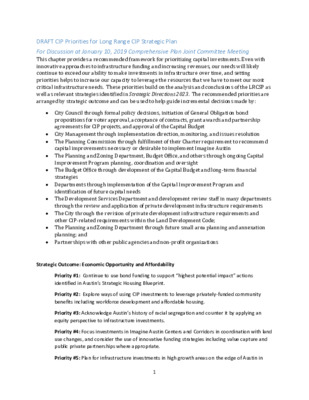draft priorities — original pdf
Backup

1 DRAFT CIP Priorities for Long Range CIP Strategic Plan For Discussion at January 10, 2019 Comprehensive Plan Joint Committee Meeting This chapter provides a recommended framework for prioritizing capital investments. Even with innovative approaches to infrastructure funding and increasing revenues, our needs will likely continue to exceed our ability to make investments in infrastructure over time, and setting priorities helps to increase our capacity to leverage the resources that we have to meet our most critical infrastructure needs. These priorities build on the analysis and conclusions of the LRCSP as well as relevant strategies identified in Strategic Directions 2023. The recommended priorities are arranged by strategic outcome and can be used to help guide incremental decisions made by: City Council through formal policy decisions, initiation of General Obligation bond propositions for voter approval, acceptance of contracts, grant awards and partnership agreements for CIP projects, and approval of the Capital Budget City Management through implementation direction, monitoring, and issues resolution The Planning Commission through fulfillment of their Charter requirement to recommend capital improvements necessary or desirable to implement Imagine Austin The Planning and Zoning Department, Budget Office, and others through ongoing Capital Improvement Program planning, coordination and oversight The Budget Office through development of the Capital Budget and long-term financial strategies Departments through implementation of the Capital Improvement Program and identification of future capital needs The Development Services Department and development review staff in many departments through the review and application of private development infrastructure requirements The City through the revision of private development infrastructure requirements and other CIP-related requirements within the Land Development Code; The Planning and Zoning Department through future small area planning and annexation planning; and Partnerships with other public agencies and non-profit organizations Strategic Outcome: Economic Opportunity and Affordability Priority #1: Continue to use bond funding to support “highest potential impact” actions identified in Austin’s Strategic Housing Blueprint. Priority #2: Explore ways of using CIP investments to leverage privately-funded community benefits including workforce development and affordable housing. Priority #3: Acknowledge Austin’s history of racial segregation and counter it by applying an equity perspective to infrastructure investments. Priority #4: Focus investments in Imagine Austin Centers and Corridors in coordination with land use changes, and consider the use of innovative funding strategies including value capture and public private partnerships where appropriate. Priority #5: Plan for infrastructure investments in high growth areas on the edge of Austin in 2 tandem with annexation. Strategic Outcome: Mobility Priority #6: Invest in infrastructure that supports development of a multi-modal transportation system called for by the Austin Strategic Mobility Plan and supports regional investments in transit. Priority #7: Invest in infrastructure that reduces the risk of serious injury and supports Vision Zero. Strategic Outcome: Safety Priority #8: Collaboratively and comprehensively assess the vulnerabilities and interdependencies that exist for critical city infrastructure, and prioritize investments in infrastructure that allow us to better prepare for, respond to, and recover from hazards and threats such as flooding, wildfire, cyber breaches, and terror attacks. Strategic Outcome: Health and Environment Priority #9: Invest in infrastructure that supports access to healthy and affordable foods and healthcare, particularly in historically marginalized communities. Priority #10: Leverage innovative funding and partnerships to support, maintain, and expand parks, open spaces, recreational facilities, and our urban trail network. Priority #11: Integrate nature into the city by investing in green infrastructure that creates a network of natural lands and other open spaces while dispersing environmental risks equitably across the city. Priority #12: Invest in a variety of energy, water, and air quality programs and initiatives that emphasize conservation and environmental protection and are aligned with long-term environmental policy goals. Strategic Outcome: Culture and Lifelong Learning Priority #13: Make investments that strengthen our portfolio of culture and lifelong learning programs, events and facilities and build trust with the community. Priority #14: Leverage City-owned assets (buildings and land) to increase the amount of affordable creative space that is available to working artists, and incentivize the equitable and inclusive development, redevelopment, and use of other publically owned assets for creative space. Strategic Outcome: Government that Works For All Priority #15: Continue to demonstrate financial stewardship by following the policies and practices that have earned the City our high bond ratings, and strengthen formation, management, and accountability around contracts and grants, and align resource allocation with the six strategic outcomes in the ways that yield the greatest impact. 3 Priority #16: Utilize a transparent data-driven process to prioritize improvements to and management of 1) our buildings, facilities, and information technology to maximize the experience of our customers and employees; and 2) our electric, water, wastewater, stormwater, and transportation infrastructure to minimize lifecycle costs and maximize service delivery. Priority #17: Prioritize use of annual capital budget funds for most critical capital renewal projects and continue to seek additional resources for capital renewal. Invest in assets with a higher percentage of poor and failing conditions. Priority #18: Develop projects in areas where those projects can achieve multiple priorities from existing plans and policy initiatives, such as those identified in areas of high overlap in the LRCSP Strategic Investment Analysis.